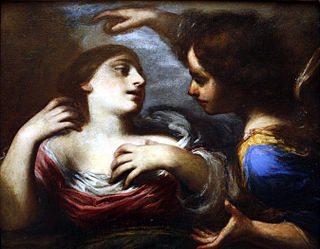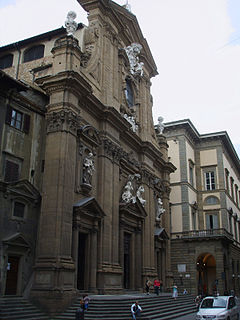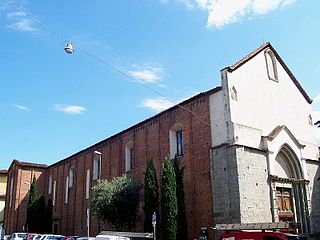Pietro Marchesini (April 7, 1692 - October 24, 1757) was an Italian painter of the Baroque period, active in Tuscany.

Pietro Marchesini (April 7, 1692 - October 24, 1757) was an Italian painter of the Baroque period, active in Tuscany.

He was born in Pistoia. He was patronized by Lorenzo Maria Gianni, and studied with Anton Domenico Gabbiani in Florence. For the Gianni family, he often traveled to create a number of copies of originals of Titian, Veronese, Raphael, Carracci, and Andrea del Sarto. His travels gave his paintings a venetian coloring. He painted a Santa Margherita for the church of the Ognissanti in Florence; a St Thomas for the church of San Lorenzo. He also painted in Pistoia and the church of Valdibure. [1]

Andrea del Verrocchio, born Andrea di Michele di Francesco de' Cioni, was a sculptor, Italian painter and goldsmith who was a master of an important workshop in Florence. He apparently became known as Verrocchio after the surname of his master, a goldsmith. Few paintings are attributed to him with certainty, but a number of important painters were trained at his workshop. His pupils included Leonardo da Vinci, Pietro Perugino and Lorenzo di Credi. His greatest importance was as a sculptor and his last work, the Equestrian statue of Bartolomeo Colleoni in Venice, is generally accepted as a masterpiece.

Benozzo Gozzoli was an Italian Renaissance painter from Florence. A pupil of Fra Angelico, Gozzoli is best known for a series of murals in the Magi Chapel of the Palazzo Medici-Riccardi, depicting festive, vibrant processions with fine attention to detail and a pronounced International Gothic influence. The chapel's fresco cycle reveals a new Renaissance interest in nature with its realistic depiction of landscapes and vivid human portraits. Gozzoli is considered one of the most prolific fresco painters of his generation. While he was mainly active in Tuscany, he also worked in Umbria and Rome.

Lorenzo di Credi was an Italian Renaissance painter and sculptor best known for his paintings of religious subjects. He is most famous for having worked in the studio of Andrea del Verrocchio at the same time as the young Leonardo da Vinci.

Signa is a comune (municipality) in the Metropolitan City of Florence in the Italian region Tuscany, located about 12 kilometres (7 mi) west of Florence.

Matteo Rosselli was an Italian painter of the late Florentine Counter-Mannerism and early Baroque. He is best known however for his highly populated grand-manner historical paintings.

Cecco Bravo was an Italian painter of the Florentine Baroque school. His true name is Francesco Montelatici.

Ignazio Hugford, or Ignatius Heckford (1703–1778), was an Italian painter active mostly in Tuscany in an early Neoclassic style.

Giovanni da San Giovanni, also known as Giovanni Mannozzi, was an Italian painter of the early Baroque period.

Giovanni Stefano Marucelli was an Italian painter and architect of the Baroque period, active in Tuscany, including Florence and Pisa.

San Gaetano, also known as Santi Michele e Gaetano, is a Baroque church in Florence, Italy, located on the Piazza Antinori.

Lorenzo Pucci was an Italian cardinal and bishop from the Florentine Pucci family. His brother Roberto Pucci and his nephew Antonio Pucci also became cardinals.

Niccola Cianfanelli was an Italian painter and restorer. He mainly painted historic and sacred subjects in a Neoclassical style.

Pietro Anderlini, also Andorlini, (1687–1755) was an Italian painter of the Rococo period.
Teodoro Matteini was an Italian painter, mainly of historical and religious subjects in a Neoclassical style.

San Domenico is a Romanesque and Gothic-style, Roman Catholic church located in the Piazza of the same name, with a north flank of the nave parallel to Corso Silvani Fedi, in Pistoia, region of Tuscany, Italy.
Giovanni Domenico Piastrini (1678–1740) was an Italian painter of the Baroque period, active in Tuscany and Rome.

Sebastiano Vini, also known as Bastiano Veronese was an Italian painter of the Renaissance period, active mainly in Tuscany.
Niccolò di Tommaso was an Italian painter active in Florence, Naples and Pistoia.

The Fioravanti family were a noble family originating in Pistoia in Tuscany and active in Florence and other Italian towns. They were Guelf in their politics and naturally allied with the Cancellieri family and adversaries of the Ghibelline Panciatichi family. An early record dates to 1267, when Fioravanti d'Accorso was a member of the town council. In 1310 Ranieri, his son, was Mayor of the Pistoia. In 1319 Simone di Ranieri was a member of the elders. Giovanni di Puccio di Ranieri Fioravanti was a banker active at the court of Pope Clement V (1305-1314) in Avignon. Andrea di Simone di Baldo Fioravanti was elected Capitano della Montagna Superiore, June 17, 1354. Francesco di Rinieri was the Gonfaloniere of the Florentine Republic in the years 1385 and 1389: Neri his son was also Gonfaloniere in 1428; Fioravanti di Piero was the Cavalry Captain in Flanders in 1510 and then for Pope Alessandro VI, commissioner at Assedius of Faenza: Vincenzo di Cipriano one of the first to be elected knight of Santo Stefano, in 1576, shortly after the establishment of that military order, and later Chancellor of the Order: Fabio of Cipriano, was Cavalry Captain in the Netherlands: Alberto di Fioravanti Knight of Malta in 1590, and Commendatore in 1610: Niccolao di Fioravanti captain in the emperor Ferdinand II against the King of Sweden in 1636, and in 1643 in Tuscany for the Grand Duke against the Barberini.
Roberto Barni is an Italian sculptor.